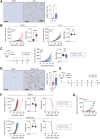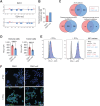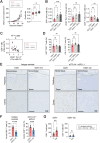Cancer-Associated Fibroblasts Suppress CD8+ T-cell Infiltration and Confer Resistance to Immune-Checkpoint Blockade
- PMID: 35749591
- PMCID: PMC9379365
- DOI: 10.1158/0008-5472.CAN-21-4141
Cancer-Associated Fibroblasts Suppress CD8+ T-cell Infiltration and Confer Resistance to Immune-Checkpoint Blockade
Abstract
Immune-checkpoint blockade (ICB) promotes antitumor immune responses and can result in durable patient benefit. However, response rates in breast cancer patients remain modest, stimulating efforts to discover novel treatment options. Cancer-associated fibroblasts (CAF) represent a major component of the breast tumor microenvironment and have known immunosuppressive functions in addition to their well-established roles in directly promoting tumor growth and metastasis. Here we utilized paired syngeneic mouse mammary carcinoma models to show that CAF abundance is associated with insensitivity to combination αCTLA4 and αPD-L1 ICB. CAF-rich tumors exhibited an immunologically cold tumor microenvironment, with transcriptomic, flow cytometric, and quantitative histopathologic analyses demonstrating a relationship between CAF density and a CD8+ T-cell-excluded tumor phenotype. The CAF receptor Endo180 (Mrc2) is predominantly expressed on myofibroblastic CAFs, and its genetic deletion depleted a subset of αSMA-expressing CAFs and impaired tumor progression in vivo. The addition of wild-type, but not Endo180-deficient, CAFs in coimplantation studies restricted CD8+ T-cell intratumoral infiltration, and tumors in Endo180 knockout mice exhibited increased CD8+ T-cell infiltration and enhanced sensitivity to ICB compared with tumors in wild-type mice. Clinically, in a trial of melanoma patients, high MRC2 mRNA levels in tumors were associated with a poor response to αPD-1 therapy, highlighting the potential benefits of therapeutically targeting a specific CAF subpopulation in breast and other CAF-rich cancers to improve clinical responses to immunotherapy.
Significance: Paired syngeneic models help unravel the interplay between CAF and tumor immune evasion, highlighting the benefits of targeting fibroblast subpopulations to improve clinical responses to immunotherapy.
©2022 The Authors; Published by the American Association for Cancer Research.
Figures







References
-
- Wei SC, Duffy CR, Allison JP. Fundamental mechanisms of immune-checkpoint blockade therapy. Cancer Discov 2018;8:1069–86. - PubMed
-
- Loi S, Michiels S, Adams S, Loibl S, Budczies J, Denkert C, et al. The journey of tumor-infiltrating lymphocytes as a biomarker in breast cancer: clinical utility in an era of checkpoint inhibition. Ann Oncol 2021;32:1236–44. - PubMed
-
- Cortes J, Cescon DW, Rugo HS, Nowecki Z, Im SA, Yusof MM, et al. Pembrolizumab plus chemotherapy versus placebo plus chemotherapy for previously untreated locally recurrent inoperable or metastatic triple-negative breast cancer (KEYNOTE-355): a randomised, placebo-controlled, double-blind, phase 3 clinical trial. Lancet 2020;396:1817–28. - PubMed
Publication types
MeSH terms
Substances
Grants and funding
LinkOut - more resources
Full Text Sources
Medical
Molecular Biology Databases
Research Materials

